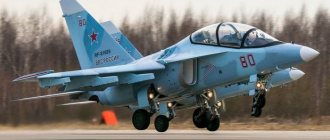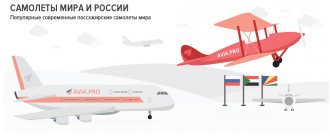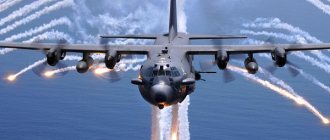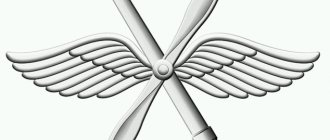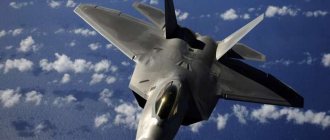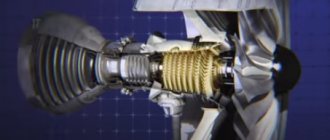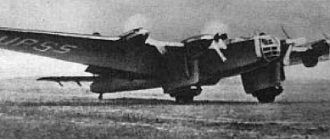Vertical take-off aircraft appeared when the era of jet aviation began, this was the second half of the fifties. Initially they were called turboplanes. At that time, designers began to develop devices that were capable of taking off with minimal takeoff or without it at all. Such devices do not require a special runway; a flat field or helipad is sufficient for them.
In addition, humanity at that time was very close to the exploration of outer space. The development of spaceships capable of landing and taking off to other planets began. Any development ends with the construction of a prototype, which undergoes comprehensive testing for the further creation of serial equipment. The first turbo aircraft was created in 1955. He looked very strange. This type of vehicle had neither wings nor a tail unit. It was equipped with only a turbojet engine directed vertically downward, a small cabin and fuel tanks.
It rose upward due to the jet stream of the engine. Control was carried out using gas rudders, i.e. the jet stream coming out of the engine, which was deflected by flat plates located near the nozzle. The first device weighed about 2340 kg and had a thrust of 2835 kg.
Vertical takeoff and landing photo
The first flights were carried out by test pilot Yu. A. Garnaev. Test flights were very unpredictable, because there was a very high probability of capsizing, and the device did not have much stability. In 1958, the device was demonstrated at an aviation festival in Tushino. The device went through the entire testing program and a huge amount of material for analysis was accumulated.
The collected material was used to create the first full-fledged Soviet experimental vertical take-off aircraft. This aircraft was named Yak-36, and the modified Yak-38 aircraft went into production. The main location of the aircraft was aircraft carriers, and it performed the tasks of an attack aircraft.
A brief history of the creation of vertical take-off and landing aircraft
Due to the development of the technical side of turbojet engines in the 50s of the last century, it became possible to create an aircraft with vertical take-off. A big impetus for the development of VTOL aircraft was the active development of jet aircraft in the advanced countries of the world. It should be noted that these devices had a high speed during landing and takeoff; accordingly, it was necessary to create a long runway, and accordingly they must have a hard surface. This requires additional cash injections. During hostilities, there were very few airfields that could accommodate such aircraft, so the creation of an aircraft with vertical takeoff and landing could solve a lot of problems.
During these years, a huge number of variants and prototypes were produced, which were built in one or two copies. In most cases, they crashed during testing, after which the projects were closed.
In 1961, the NATO Commission put forward requirements for a fighter with vertical landing and take-off, which gave additional impetus to the development of this area of aircraft construction. After this, they planned to create a competition to select the most promising designs. But the competition never took place, since it became clear that each advanced country had its own versions of such an aircraft.
Under the influence of technical and political problems, the NATO commission changed the concept and put forward new requirements for the apparatus. After this, the design of multi-purpose machines began. Ultimately, only two options were selected. The first was the aircraft of the French designers "Mirage" III V", 3 aircraft were created and the designers of the Federal Republic of Germany VJ-101C produced 2 copies. After the tests, 4 devices were lost. Because of this, it was decided to develop a fundamentally new vehicle, the XFV-12A.
Development of VTOL aircraft in the USSR and Russia
The first aircraft of this class in the USSR was the Yak-36, which the Yakovlev Design Bureau began to develop in 1960. For this purpose, a training stand was made. The first flight was carried out in March 1966, in this test a vertical take-off was carried out with the transition to horizontal flight, after which the machine landed vertically. After this, the Yak-38 and the more famous Yak-141 were created. In the 90s, another project was started with the designation Yak-201.
Troubles on production aircraft
After the completion of state tests and the recommendation to accept the aircraft into service in 1974, in the Crimean city of Saki, a special group of ten naval aviation pilots was formed, which in the summer of the same year, together with a group of engineering and technical staff, began a theoretical study of the experimental Yak-Z6M at the Saratov Aviation Plant , its power plant - at enterprises in Moscow and Rybinsk, as well as rescue equipment.
Serial production of VTOL aircraft began with the Yak-36M under the designation Yak-38 in 1973 in Saratov (originally planned at the Irkutsk plant). Over 15 years, 231 aircraft were produced there, including 50 Yak-38M and 38 Yak-38U. From 1976 to 1991, the “thirty-eighths” and their modifications were in service with three naval attack air regiments and participated in long-distance cruises of our aircraft-carrying cruisers of the “Kyiv” type of the Northern and Pacific fleets. The most intensive period of flights was the cruiser's transition from Severomorsk to the Mediterranean Sea and back - then, from December 15, 1978 to March 28, 1979, 355 sorties were carried out.
The first troubles began on April 4, 1975 - experienced OKB pilot A.S. Yakovlev Mikhail Dexbach (later an honored test pilot, Hero of the Soviet Union), while trying to make a vertical landing, one of the lift engines did not start, and the plane literally crashed to the ground from a height of 20 m. The pilot received a serious spinal injury, and the plane was subject to write-off. On December 27, 1979, Dexbach failed again - the Yak-38U two-seater training vehicle (Dexbach was in the second cockpit, piloted by Oleg Kononenko, who died in a test flight a year later) failed, the nozzle rotating mechanism failed, both pilots ejected, and the plane sank.
The use of "Yaks" was especially difficult in southern latitudes due to the deterioration of the traction characteristics of the engines at high temperatures and air humidity. So, in March 1979, when passing through the tropics from Cape Horn, the aircraft's lifting engines stopped starting. The designers proposed installing two additional oxygen cylinders to recharge the engines, which made it possible to continue flights.
During the operation of the Yak-38, shortcomings of the vehicle were identified that reduced its combat potential. The design was improved in several stages: to increase the combat radius, a short take-off technique was developed and implemented, which was provided for when the technical specifications were approved. The next step was the launch into mass production of a modernized version of the attack aircraft - the Yak-38M with more powerful engines and increased reserves of fuel and weapons.
In total, 48 VTOL aircraft were lost in various flight accidents, including 38 Yak-38, seven Yak-38U and three Yak-38M. Strange things also happened: during heavy seas in the South China Sea, on November 4, 1982, one of the planes fell off its moorings, fell overboard and drowned.
The collapse of the USSR and the deepest economic crisis put an end to the career of our VTOL aircraft - without the necessary supervision from the manufacturer, the resource of many aircraft was quickly exhausted, they mostly stood idle at air bases, the Saratov plant was unable to solve the problem of supplying the necessary spare parts. The Yak-38 began to be withdrawn from the Navy Air Force in the summer of 1991 - both those that had served their service life and new ones. There was no replacement for them.
I consider this a huge omission, because in those years the United States had a high power of its aircraft carrier fleet. To some extent, their dominance at sea could be challenged precisely through the construction of aircraft carriers with Yak-38 type aircraft on board. This would allow us to avoid the high costs of building huge aircraft carriers.
Layout diagram
Depending on the position of the fuselage
- Vertical.
With screws.
- Reactive.
Using thrust directly from a propulsion jet engine.
- Coleoptera (ringed wings).
- With screws.
Rotary wing and propellers.
- Rotary type motor.
Performance characteristics
| Takeoff weight (maximum) | 15.8 tons with vertical take-off, 19.5 tons with full takeoff. |
| Aircraft weight without fuel and payload | 11.65 tons |
| Fuel reserve | 4400 kg in internal tanks; 1750 kg suspended. |
| Aircraft height | 5 m |
| Length | 18.3 m |
| Wingspan | 10.1 m unfolded; 5.9 m folded |
| Engine power | Two 4100 kgf each and one (lifting and sustaining) - 15 500 kgf |
Vertical takeoff and landing
At the same time, a similar aircraft was being developed in England. In 1954, the Harrier vertical take-off aircraft was built. It was equipped with two engines with a thrust of 1840 kg. The weight of the aircraft was 3400 kg. The plane turned out to be extremely unreliable and crashed. Watch vertical takeoff and landing .
The next step in the development of such devices was the American aircraft, built in 1964. The construction coincided with the development of the lunar program.
Despite the fact that breakthroughs in the field of aircraft manufacturing do not delight us every day, there are a lot of new developments in the field of civil aviation. A typical example of this is the development of a modern vertical take-off passenger airliner.
The main features of aircraft with vertical take-off are, first of all, that a large space is not required for take-off and landing of the aircraft - it should only slightly exceed the dimensions of the aircraft, and from here there is a very interesting conclusion that with the development of airliners with a vertical take-off system, Air travel between different regions will become possible, even those without any airfields. In addition, it is not at all necessary to make such airliners spacious, because 40-50 seats are quite enough, which will make air travel as cost-effective and comfortable as possible.
Vertical take-off video - watch above
However, a vertical take-off aircraft will most likely not be famous for its speed, since even in military aircraft it does not exceed 1100 kilometers per hour, and given that a passenger aircraft with a vertical take-off will carry a relatively large number of people, then most likely its cruising speed will be the speed will be about 700 kilometers per hour. However, on the other hand, the reliability of air travel will increase significantly, since in the event of any unforeseen situation, a vertical take-off aircraft can easily land on a small, flat area.
Today, there are a number of concepts for future passenger airliners with a vertical take-off system. Until recently, they seemed incredible, but modern developments in the field of aircraft manufacturing indicate the opposite, and it is quite possible that in the next ten years, the first modern aircraft with vertical take-off will begin to transport their passengers.
Sunset time
By that time, the United States had again lagged behind in the development of VTOL aircraft, devoting all its efforts to creating “stealth” aircraft. But the need for “verticals” remained - these planes were too convenient: they could take off not from giant aircraft carriers, but from fairly modest UDCs. It was then that the idea was born to “save money” and make a single “stealth” aircraft - a light fighter-bomber, a carrier-based fighter-bomber and a VTOL aircraft. This is how the JSF program slowly began. British input helped Lockheed Martin easily beat rivals Boeing in 2001, but it took more than a decade to get the F-35 up and running.
It is interesting that initially the British BAE collaborated with McDonnell-Douglas and Northrop, but after the acquisition of MDD Boeing, the latter decided that there was no point in sharing profits and they could do everything on their own. The result is known
At the same time, the F-35B cannot formally be considered a VTOL aircraft: it is not capable of taking off vertically with any serious payload; it needs a short take-off run. That’s why, according to the official classification, it is a short take-off aircraft. And to this day there are debates: if they decided to make the F-35 like a regular aircraft, how much cheaper it would have been and how much faster it would have been designed. And in general, was all this effort worth the final result?
At the moment, there is only one real VTOL aircraft left in the world - the Harrier II, which is reaching its final years. It will soon be replaced by the F-35B. Soviet VTOL aircraft have long since retired. VTOL aircraft are currently not being developed anywhere in the world (there are rumors about similar programs here and in China, but so far there is no evidence of this). And, if we leave out the helicopters, which are still closer to helicopters, we can say that the idea of a combat VTOL aircraft is almost dead.
One can only recall the semi-mythical Yak-201 project, work on which has probably not been carried out for a long time.
No matter how hard the designers and engineers try, vertical takeoff, even with the most modern propulsion systems, is unprofitable; too much fuel is spent on this task. Therefore, it is necessary to reduce take-off weight and optimize the load in favor of higher fuel costs.
And there is no way to solve this problem: taking off with a normal take-off run will always be more profitable.
The second important point is the price. For an aircraft with poor performance characteristics you have to pay almost more than for a regular one.
Could this trend change? Unlikely in the foreseeable future. Even if more powerful engines become available, it will again be more efficient to put them on conventional aircraft. Moreover, rotorcraft are gradually coming on the heels of VTOL aircraft, flying faster and further. And despite the success of the F-35, we may be witnessing the final decline of the VTOL era.
Disadvantages and advantages of VTOL aircraft
Without exception, all devices of this type were created for military needs. Of course, the advantages of such machines for the military are obvious, since the aircraft can be operated in small areas. Airplanes have the ability to hover in the air and at the same time make turns and fly sideways. When compared with helicopters, it is clear that the greatest advantage of airplanes is their speed, which can reach supersonic levels.
However, VTOL aircraft also have significant disadvantages. First of all, it is difficult to control; this requires high-class pilots. Special skill is required from the pilot during the transition of modes.
It is the complexity of control that poses many challenges for the pilot. When switching from hovering mode to horizontal flight, it is possible to slide to the side, which creates additional problems when holding the aircraft. This mode requires a lot of power, which can lead to engine failure. The disadvantages include the small carrying capacity of the VTOL aircraft, while it uses a huge amount of fuel. During operation, specially prepared sites are required that are not destroyed under the influence of gas exhaust from engines.
Design Features
There are three main fundamental differences between the Yak-141 fighter and all conventional “horizontal” aircraft:
- Combined power plant with rotary engine nozzles;
- Jet rudders;
- Automatic ejection system.
It is these features that allow the aircraft to perform a fully vertical or short takeoff, while providing the necessary level of safety for the pilot.
Glider
When creating the aircraft, the designers chose a normal aerodynamic design. At the same time, the Yak-141 is noticeably different from its predecessor, the Yak-38 attack aircraft, primarily in the location of the wing - the new aircraft has become a high-wing aircraft. The main material used in the manufacture of the airframe is alloys based on aluminum and lithium. They make up almost 74% by weight. The rest is mainly (26%) made up of composite materials. Individual parts are made of titanium-based alloys that are resistant to high temperatures, as well as hardened steel.
Model Yak-141. The main engine nozzle is shown at its maximum position and the lift engine doors are open.
Fuselage
The nose of the fuselage is used to house the Zhuk radar and the pilot's cabin, which is covered by a pointed fairing. Next comes the lifting engine compartment and fuel tanks. The tail contains the main engine and a small compartment for a parachute (can be used during a “horizontal” landing to reduce mileage). When designing the fuselage, the area rule was taken into account.
Wing
The Yak-141 is a supersonic aircraft, which is ensured, in particular, by the trapezoidal wing shape chosen for this machine, which has a kink at the trailing edge and sagging at the root. The mechanization consists of flaps, elevons (a control element that acts as an aileron and elevator at the same time) and rotary socks. The wing is made folding, which simplifies the transportation of the fighter and its placement on a small area.
Tail
The Yak-141 has two fins. They are installed at a slight angle of inclination on cantilever beams located at the rear of the aircraft, on both sides of the main engine nozzle and extended back a fairly large distance. The keels are equipped with rudders. In addition, the tail unit includes two all-moving stabilizers. They are installed slightly below the longitudinal line of the wing.
Air intakes
To provide the lift-propulsion engine with the necessary volume of air during takeoff, the adjustable rectangular air intakes are equipped with special side valves.
The air intakes of the Yak-141 aircraft have a very impressive cross-section
In vertical take-off mode, to improve engine efficiency, transverse flaps (partitions) are used, which extend under the air intakes and help avoid recirculation of air jets. To make it easier for hot gases to escape from the fuselage, there are special longitudinal partitions on the sides of the air intakes, in their lower part.
Chassis
The plane is capable of withstanding a “flat” fall from a height of five meters. This is ensured by a three-wheel chassis. All supports are single-wheeled. The main struts are cleaned under the air intake ducts, forward along the flight. The front wheel retracts in the opposite direction, into the fuselage niche.
Power point
The Yak-141 is equipped with three engines. Two of them (lifting) are turned on only during takeoff and landing, the third, the main one (lifting and sustaining), operates throughout the entire flight.
Lifting propulsion engine
Especially for the Yak-141 multi-purpose aircraft, AMNTC Soyuz created the R79V-300 lift-propulsion engine with a thrust vector deflected in the vertical plane, which is ensured by a nozzle that can be rotated downwards, up to an angle of 95 degrees. The cross-sectional area of the nozzle is adjustable. In afterburner, this engine creates a thrust of 15,500 kgf.
The nozzle rotation mechanism has a service life of one and a half thousand cycles (this is the minimum estimate). The engine provides fully vertical, short and ultra-short take-off. In the last two cases, the nozzle rotation angle should be 65 degrees. It should be noted that takeoff with a range, even the shortest, can significantly increase the payload mass and increase the combat radius.
Lifting motors
Vertical take-off of the Yak-141, all three engines are used.
The fighter is equipped with two RD-41 lift engines, which were created at the Rybinsk Engine Design Bureau. To accommodate them, a special compartment is used, located directly behind the cabin. Thanks to the use of a special device attached to the nozzle of each engine, it is possible to deflect the longitudinal thrust vector at angles in the range from -12.5 to +12.5 degrees.
To form a single jet stream during takeoff, the takeoff engines turn towards each other. In horizontal flight, they are turned off, and the compartment provided for them is automatically closed with special flaps (on the ground they are also in the closed position).
It was possible to use lifting engines to perform various evolutions in the air, however, this is only possible when flying at a speed of 550 km/h or less.
Jet rudders
Since it is not possible to use conventional controls when performing vertical takeoff and landing, the Yak-141 is equipped with jet rudders - small nozzles that are located at the wingtips and in the front part of the fuselage. With their help, you can change the roll angle and direction (course). To raise or lower the nose of a fighter, the pilot can vary the thrust ratio of the lift-propulsion and lift engines.
Fuel tanks
Approximately in the middle of the Yak-141 fuselage there are internal fuel tanks. In addition, fuel is also located in the rear part of the hull, inside each of the tail booms. Additional drop tanks can be installed on standard mounting points located under the wing, and space for another tank (conformal, 2000 liters) is located under the fuselage.
Yak-141 in the parking lot. Under the wing, pylons for beam holders are visible, on which weapons are suspended
Onboard equipment and systems
There are several main types of aviation equipment installed on board the fighter, designed to control the aircraft, navigate, search for targets and point guided missiles at them, as well as to perform various control functions. All this equipment is distributed in three compartments, one of which is located in the tail, the other in the front part of the fuselage, and the third near the air intakes.
Electronic and sighting equipment
The main part of the weapons control system is the Zhuk radar, slightly modified compared to the version installed on the MiG-29 fighters. Reducing the diameter of the main antenna, caused by the need to “fit” the radar into the contours of the Yak-141 fuselage, somewhat reduced the characteristics of the radar, but it is still capable of detecting targets the size of an F-16 at an eighty-kilometer distance.
The Zhuk can detect enemy ships, including boats, at a distance of up to 110 kilometers. Provides automatic tracking of ten targets with simultaneous firing of four of them. Data processing is carried out by an on-board computer.
The Yak-141 uses active jamming. The devices necessary for this are located on the tips of the wing consoles and in the upper part of each of the fins. It was also planned to equip the aircraft with a device for releasing passive interference.
The antenna located in front of the cabin is part of the "Password" system used for government identification.
Flight and navigation complex
The Yak-141 carried out flights with mass-sized mock-ups of weapons, however, today you can only see missiles under the wing of this aircraft on a model.
Although the GLONASS system did not yet exist in the 80s, the Yak was already adapted for its use. When performing test flights, a conventional inertial system was used to solve navigation problems. In addition, there was equipment that provided automatic landing on the deck of the ship.
The main control system is fly-by-wire. With its help, not only the tail surfaces are controlled, but also the jet rudders. A mechanical control was also installed, which could be used in emergency situations.
Communication and guidance complex
The Yak-141 pilot is provided with the opportunity to communicate with ground guidance points and other aircraft in both the decimeter and meter wavelength range. For each of them there is a special radio station on board. In addition, equipment was installed to encrypt conversations.
Power supply system
Backup sources of electricity for the Yak-141 are two batteries. Main power is provided by generators connected to the main engine. The equipment set also includes two rectifiers and static converters.
Registration, control and alarm equipment
The left tail boom of the fighter is used to install a flight recorder that records everything that happens during the flight. Equipment serviceability is checked by a special automated control system. There is also an alarm system that notifies the pilot of dangerous or emergency situations.
Cabin of the Yak-141
The interior of the cockpit of one of the experimental Yak-141 aircraft.
The rescue of the pilot is ensured by the K-36LV seat located in the cockpit, which can be activated either by the pilot himself or by automation. The canopy is made of plexiglass and has a flat front piece made of transparent armor. The display of flight information was supposed to be carried out on multifunctional indicators, the same as on the MiG-29, but they simply did not have time to install them. Nevertheless, the HUD (a device for projecting flight information onto the plane of the windshield) was already available. The use of a helmet-mounted target designation system was also envisaged.
What do you need to know about such aircraft?
First of all, you need to know that a vertical takeoff and landing aircraft really exists. The first models began to appear simultaneously with the development of jet aviation, and since then they have been haunting engineers all over the world. In time, this coincides with the second half of the last century. They had a very telling name - “ turboplanes ”. Since there was a boom in military technology development at that time, engineers were required to develop a device that would lift air with minimal effort or even from a vertical position. Such aircraft do not require a runway, which means they can take off from anywhere and in any conditions, even from the mast of a ship.
All these projects coincided with others, no less important, related to space exploration. The overall symbiosis allowed us to double our efforts and draw ideas from space design. As a result, the first vertical device was released in 1955. We can say that it was one of the strangest buildings in the history of technology. The plane had no wings, no tail - only an engine (turbojet), a bulb-shaped cabin, and fuel baths. The engine was made at the bottom. The following features of the first turboflight can be highlighted:
- Lifting due to the jet stream from the engine.
- Control via gas rudders.
- The weight of the first device is a little more than 2000 kilograms.
- Traction – 2800 kilograms.
Why have vertical aircraft not yet found widespread use?
Unfortunately, all developments, even if they had good results, cannot boast of reliability. The propeller blades, which help make vertical take-off, are striking in their size. Together with powerful engines, they create unimaginable noise. Also, from a design point of view, it is necessary to avoid any possible obstacles in their path and to prevent the ingress of various objects.
No matter how you look at it, it is impossible to remove the speed limit. It’s just that, according to the laws of physics, such an aircraft will not be able to move as fast as modern ones. And if military vehicles can reach a fantastic speed of 1000 kilometers per hour in their case, then with an increase in mass and size for civil aviation, the figure drops to 700 and below kilometers per hour.
